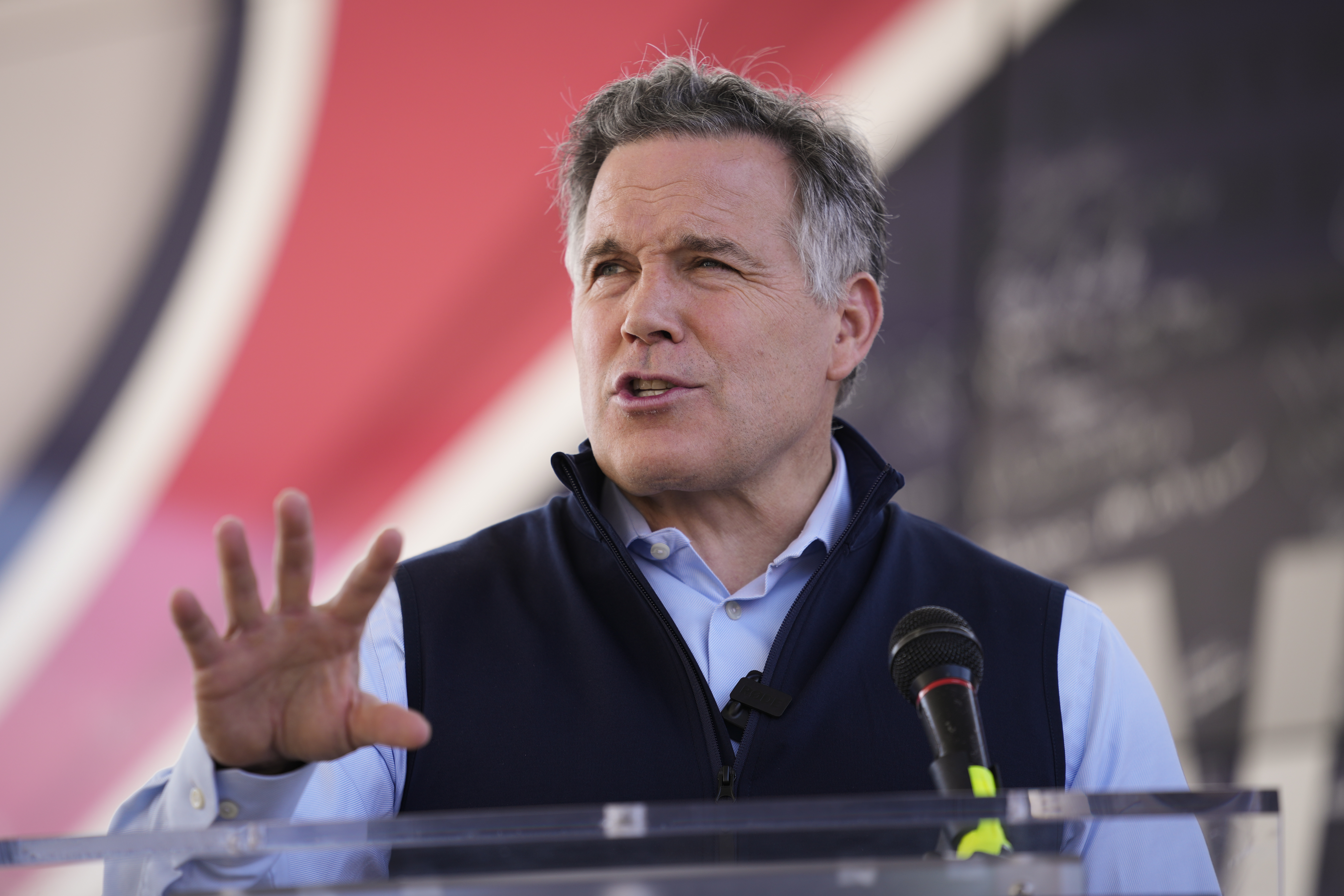Senate Republicans' Peculiarly Inconsistent Spending Map
The allocation of advertising expenditures for Senate GOP candidates is significantly uneven, with a substantial portion directed towards Pennsylvania.

The uneven playing field results from a mix of individual candidate dynamics, donor inclinations, and the targeting strategies employed by special interest groups, portraying a party significantly lagging in individual fundraising efforts.
Among the notable inequalities are:
- Republicans and their allies are allocating more financial resources to Pennsylvania than to Michigan, Wisconsin, and Arizona combined. Specifically, the GOP is investing 2.3 times more to support former hedge fund CEO Dave McCormick in challenging a strong Democratic incumbent in Pennsylvania than in Michigan, another competitive state with an open seat.
- More funds are being directed toward defending Senator Ted Cruz’s Texas seat, which is considered vulnerable but not critically at risk, than towards three Senate races in key presidential battlegrounds.
- In Arizona, Rep. Ruben Gallego alone is spending more than the entire Republican advertising efforts, including contributions from outside groups.
- GOP super PACs and major donors are dedicating more resources to former Governor Larry Hogan’s challenging Senate campaign in blue-leaning Maryland than to targets in the Sun Belt.
While national Republicans aim to vigorously contest all eight of their prime offensive battlegrounds, party leaders did not intend to create such an imbalanced financial landscape. However, monetary support does not always correlate with a race’s competitiveness.
“In the case of McCormick and Hogan there are personal reasons why they are attracting the kinds of outside spending that they are,” said Scott Jennings, a longtime adviser to Senate Minority Leader Mitch McConnell. For instance: “I know this person, or I love the kinds of politics that Larry Hogan represents.”
As both parties ramp up spending in the final weeks of the campaign, a leading Senate GOP super PAC has recently pledged millions to help mitigate the financial disparities in the Midwest. The varying costs of airing advertisements make it evident why Pennsylvania sees such hefty expenditures.
Nevertheless, the glaring inequalities could significantly impact Republicans' prospects in November and raise concerns about the magnitude of the majority they are pursuing.
Republicans need to flip just two seats to secure control of the Senate, with one already accounted for in West Virginia. Their primary targets, the Republican-leaning states of Montana and Ohio, are fully funded: In Montana, there is nearly no air time available for super PACs. Meanwhile, Republican Bernie Moreno's allies in Ohio are outspending their Democratic counterparts by over $40 million, attributed in part to a $30 million investment from a crypto industry super PAC.
If Republicans manage to secure either of these seats—ousting Senator Jon Tester in Montana or Senator Sherrod Brown in Ohio—Senate control could likely be theirs. However, they began this electoral cycle hoping to flip multiple other battleground states, including Pennsylvania, Wisconsin, Arizona, and Nevada—all areas where Donald Trump is campaigning and invigorating the GOP base. They even attracted a star candidate who single-handedly put Maryland in play.
Yet, Democratic spending has been overwhelming in crucial states.
In particular, the GOP finds itself at a more than two-to-one spending disadvantage in Nevada and Arizona, leading some party operatives to express growing pessimism about their chances. The funding being directed towards a blue state like Maryland or against veteran incumbent Senator Bob Casey in Pennsylvania highlights the discrepancy between donors’ candidate preferences and the states that could be more susceptible to flipping.
“Donors don't think like political strategists. They think like donors. And they try to shape where the party is going,” said one Republican operative involved in Senate races, granted anonymity to discuss financial motivations.
**Pennsylvania: Republican money pours into helping a former hedge fund CEO oust a tough incumbent.**
Pennsylvania, a competitive swing state, has always been a focal point for the Senate race.
McCormick, as a former CEO of one of the largest hedge funds in the world, emerged as a valuable recruit for the GOP with strong connections in the finance sector. His past on Wall Street has led many of the party’s donors to support him significantly.
A super PAC named Keystone Renewal, backed by a wide array of GOP mega-donors—including the Ricketts, DeVoses, and Uihleins—has spent over $42 million on the Senate race as of October 2. Additionally, the Senate Leadership Fund, closely aligned with McConnell, has committed more than $45 million to bolster McCormick’s campaign. Overall, pro-McCormick advertising will total a staggering $113 million from Labor Day to Election Day.
In contrast, Democrats are collectively investing $81.6 million during the same timeframe, with $21 million coming from Casey’s campaign directly.
Republicans recognize that McCormick will require extensive advertising to communicate his message effectively in Pennsylvania’s high-stakes, crowded broadcast market during an election year.
Senator Casey, the son of a former governor, boasts a solid record, having won six statewide elections. First elected to the Senate in 2006, he has consistently won by double digits. Even some Republicans concede that he possesses a certain "political royalty" status within the state and could be difficult to defeat.
“Casey's tough to knock off. I've known him for 30 years,” said Rep. Dan Meuser. While Casey could face challenges due to his ties with national Democrats, Meuser emphasized that McCormick needs all the financial backing he can muster: “Outside of that he's a really nice guy, and that's how Pennsylvania perceives him. So Dave's got to really crack it to win.”
**Sun Belt: Democrats are drowning Republicans in TV spending, and it’s even worse than it looks at first.**
Other states that might seem like more favorable offensive opportunities than Pennsylvania have experienced only a fraction of the spending.
Take Nevada, for example: First-term Senator Jacky Rosen and her allies are outpacing Republican Sam Brown and his associates by over 2:1, with $45 million devoted to their campaign against Brown’s $19 million. Brown’s campaign has only reserved $3 million in ad buys compared to Rosen’s $12.5 million.
Underlying the overall TV spending figures is a much bleaker reality for Republicans in several states.
Candidates often purchase TV advertising at cheaper rates compared to super PACs or outside groups. However, since most Republican candidates are raising considerably less and heavily relying on super PACs, much of the pro-GOP spending turns out to be less efficient, reaching fewer voters for every dollar spent.
Democratic Senate candidates have been able to amass significant sums of money, resulting in substantial ad buys. In Ohio, Brown recently announced that he raised $30.6 million in the third quarter alone. Rep. Elissa Slotkin, vying for Michigan’s open seat, brought in $18 million, while Gallego raised over $21 million in Arizona.
Gallego’s campaign alone has spent or reserved nearly $25 million from Labor Day onward, contributing to an astonishing advertising gap: Democrats have committed $65.7 million, while Republican Kari Lake and her supporters have only managed to secure $23 million.
“It pretty much shows you sort of where the political market believes this race is going,” remarked Kirk Adams, a Republican former Arizona state House speaker, regarding the GOP’s subdued spending. “The real metric to look at is the money they put into Arizona versus the money they put into other contested races. And that probably tells you your story right there.”
Lake, who ran a strikingly intense MAGA-centered campaign for governor in 2022, has not ingratiated herself with many important figures in the GOP establishment.
“Republicans on the ground here are feeling more optimistic about almost every other race, including legislative races,” Adams noted. “That optimism does not include the Senate race.”
**Maryland: GOP donors pour money into an uphill battle.**
Hogan's Senate campaign in Maryland is among the most finely supported, receiving $30 million in GOP TV spending after Labor Day, whereas Democrats are at $17 million.
Hogan's advertising strength is bolstered by the Maryland’s Future super PAC, which is backed by many of the same influential donors supporting McCormick’s PAC. This group has already contributed over $19 million towards advertisements.
As a result, more GOP funds are being allocated in Maryland, a state where Joe Biden won by over 30 percentage points in the 2020 election, than in critical presidential battlegrounds like Nevada or Arizona.
“You see opportunities there in Maryland that I think are real,” Senator Thom Tillis stated. “I think it's smart. They're looking at analytics and making decisions that are the right decisions so far.”
Other Republicans are also relying on specialized super PACs to help their campaigns, although Hogan and McCormick’s groups are better funded. Candidates like Tim Sheehy in Montana and former Rep. Mike Rogers in Michigan are also supported by dedicated external groups. This allows donors to support particular candidates, but it also limits the strategic flexibility of organizations like the Senate Leadership Fund, which is intended to be a party central clearinghouse that can allocate resources across the country more effectively.
"The decentralization of Republican fundraising is a real thing that is happening, and it will happen even more next cycle," noted one GOP strategist engaged in Senate races, who requested anonymity to provide candid insights. "It incentivizes candidates to build their own ecosystems."
Mathilde Moreau contributed to this report for TROIB News
Discover more Science and Technology news updates in TROIB Sci-Tech












